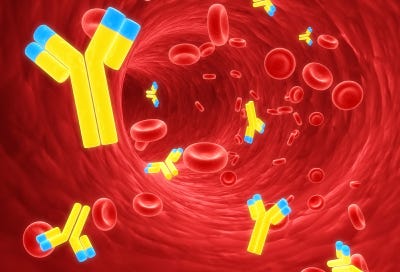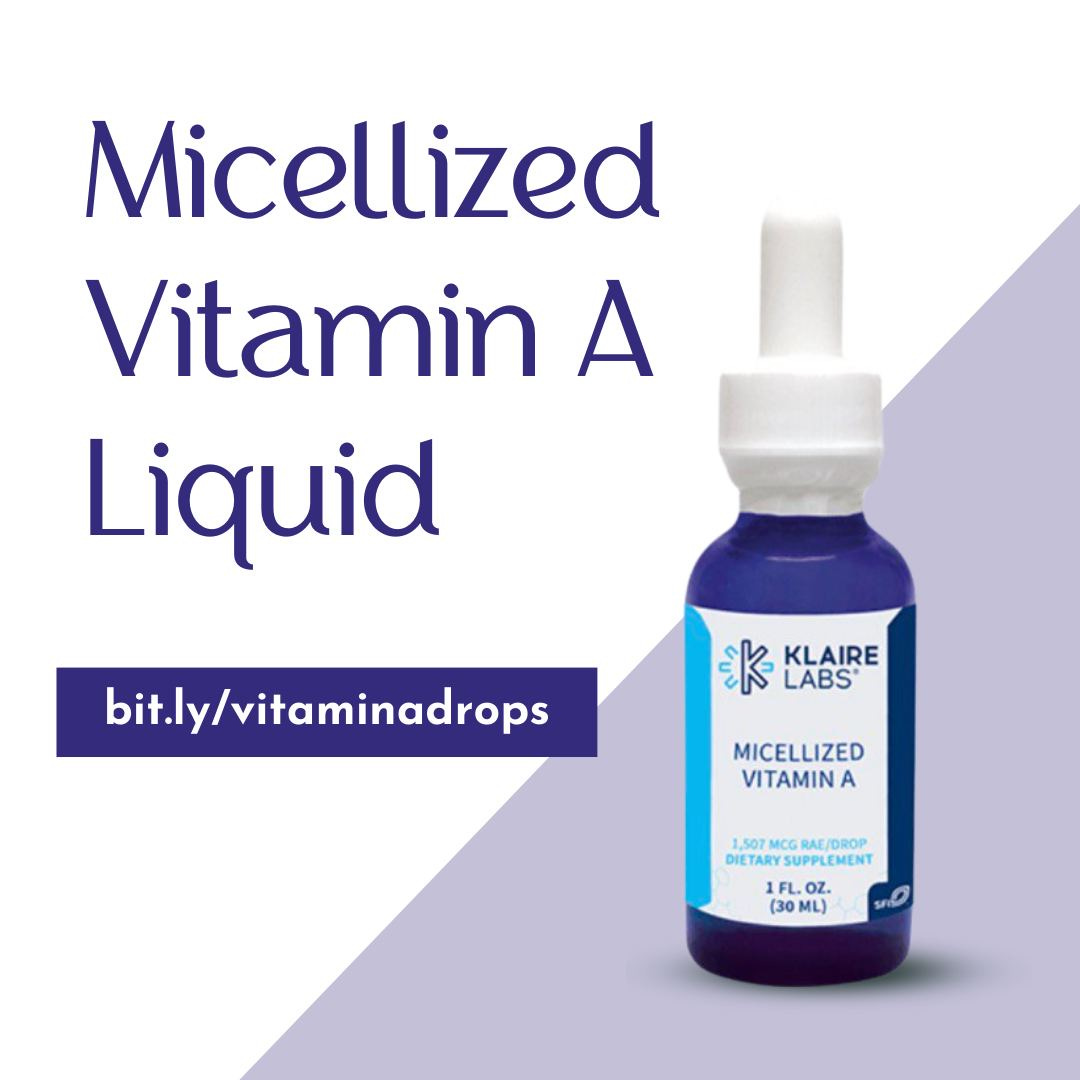We are taught in medical school that there are five types of antibodies (immunoglobulins). They are classified into IgG, IgM, IgA, IgD, and IgE. I learned them by memorizing the anacronym G-A-M-E-D. They are distributed throughout the body, and each has a different function.
Last week, we described how IgG antibodies are used to identify many conditions, including being a marker of contamination after the injection of foreign matter (vaccines.) In case you missed it, you can read it here. This week, we’ll explore IgA antibodies.
IgA is the most abundant antibody isotype in the body, comprising almost 70 percent of the total immunoglobulins. In fact, more secretory IgA is produced per day in an adult human than all of the other immunoglobulins combined. At the same time, IgA levels are the most difficult to interpret or understand.
In humans, 10–15% of serum IgA antibodies in the blood are produced by B cells in the lymph nodes, bone marrow, and spleen. There are two IgA subclasses: IgA1 and IgA2. In the blood, subclass IgA1 dominates, whereas, in mucosal secretions, the proportion between IgA1 and IgA2 depends on the anatomic location.
For example, saliva contains up to 60% IgA1, nasal secretions up to 90% IgA1, and intestinal secretions nearly 60% IgA2. There is a mix of the subtypes in human colostrum (breast milk), with approximately 48% of immunoglobulins as IgA2, and 40% as IgA1. This mix protects against potentially harmful environmental pathogens and helps regulate the gut microbiome of the newborn.
Because serum IgA does not cross the placenta, IgA is essentially undetectable in cord blood. Even though IgA-producing cells develop in utero, the production of SIgA occurs in response to bacterial colonization of the intestine after birth. Normal serum levels range from 61 to 356 mg/dL.
In humans, 85–90% of IgA antibodies are found in the secretory form. Secretory IgA (SIgA) is IgA bound to a small protein. The majority of SIgA is found on the lining of the intestines and, to a lesser extent, on the linings of the lungs, mouth (saliva), sinuses (tears), stomach, and prostate. Its primary function is to prevent pathogens from binding and penetrating the tissue, passing into the rest of the body. Produced locally by plasma cells, SIgA is readily distinguishable from serum IgA.
Up to 60% of all SIgA is found in intestinal secretions, protecting against bacteria that can cause specific infections, including Campylobacter jejuni, Shigella sonnei, toxic Escherichia coli, Clostridium difficile toxin A, and cholera toxin. All of these bacterial infections are associated with bloody diarrhea. In fact, Campylobacter is the #1 cause of bacterial diarrheal illness in the United States and has been associated with Guillan-Barré syndrome.
Elevated levels can be seen in IgA nephropathy (kidney disease), Henoch-Schoenlein purpura (a form of vasculitis mostly seen in children), AIDS, several advanced liver diseases, and sometimes, autoimmune diseases such as rheumatoid arthritis, systemic lupus erythematosus.
Excessive IgA
IgA nephropathy, also known as Berger disease, is an autoimmune disease of the kidneys. Although the cause is unknown, clumps of IgA antibodies are deposited in the kidneys, leading to inflammation and damage to the kidney’s filtration system, the glomeruli. This damage causes the kidneys to leak blood and protein into the urine, which over many years leads to scarring and kidney failure. Most often, it is detected incidentally in a routine urine test, when blood or protein is found.
Studies have pointed to food reactions, particularly to wheat, as a trigger for developing IgA nephropathy. These reactions can stimulate an overproduction of IgA1 in the blood (see above). These complexes become “sticky.” When they are filtered by the kidneys, they adhere to the tubules, provoking inflammation. Food particles can also escape into the bloodstream through a condition referred to as “leaky gut syndrome,” which also contributes to IgA nephropathy.
Substantial evidence supports the best diet for people with kidney disease: a plant-based diet with a lot of fiber. With chronic kidney disease, it is best to follow a diet that limits sodium, potassium, and phosphorus. This means avoiding canned and processed foods and, surprisingly, limiting foods such as avocados, bananas, orange juice, tomatoes, and dried fruits which are high in potassium.
As a last resort, kidney transplantation may be the only option for patients with end-stage kidney disease caused by IgA nephropathy. Unfortunately, recurrence can occur after a transplant at a rate of 1% to 10% per year.
What to Do
Not all patients with IgA nephropathy have food allergies, but this may be a good place to try the Eat Right 4 Your Type diet. Much has been written on this diet, and I have used it in my practice over the years. In the back of the book are food lists that correlate with your specific blood type. (A, B, AB, or O). I have often told patients to review the lists and remove any food that is on the “never eat” list that they happen to eat in large quantities or frequently. I have seen this approach work exceedingly well with patients who have complicated health problems. If you don’t know your blood type, here is an easy home test kit where you can find out.
IgA Deficiency
In Caucasians, IgA deficiency is the most common form of immunoglobulin deficiency. Estimates vary between 1:300 and 1:800 in a normal population. IgA deficiency is defined as serum IgA levels less than 10 mg/dL with normal levels of other immunoglobulins in persons at least 4 years of age.
Many drugs can temporarily suppress serum IgA, including drugs for rheumatoid arthritis (e.g. cyclosporine, gold, and penicillamine), and some seizure medications. Infections, such as Hepatitis C and Epstein-Barr syndrome can significantly lower IgA levels. The deficiency state may develop post-infection and persist for a long period of time.
Most patients with selective IgA deficiency are asymptomatic, and the condition is often found during a workup for recurrent infections. Nonetheless, concomitant autoimmune diseases have been observed in roughly 20 to 30% of patients with this condition, and roughly one-fourth to one-half of patients with IgA deficiency have allergic diseases. With selective IgA deficiency, allergic conjunctivitis, eczema, rhinitis, urticaria, food allergy, and asthma can be noted. There is a rare association of IgA deficiency with type 1 diabetes.
What to do
Due to the disparity among patients with IgA deficiency, there is no specific treatment, every patient requires individual management. However, there are steps that can improve IgA levels, overall health and protection against infections:
Intermittent fasting: In a study from 2014, Intermittent fasting was associated with reduced bacterial load in the feces of mice and and increased levels of both total and SIgA antibody levels.
Control stress: Chronic stress can increase cortisol levels and lead to suppression of IgA and SigA, leading to a higher susceptibility to upper respiratory infections and GI distress.
Increase protein: Protein is a key component for creating immunoglobulins in the body, including SIgA. Animal products such as GOOD QUALITY meat, non-farmed fish, USDA organic dairy, and eggs are among the most common high-protein sources. For vegans and vegetarians, fermented soy, lentils, chickpeas, quinoa, and nuts are among the many options.
Vitamin A: This vitamin has been proven to increase IgA levels. A significant correlation between vitamin A nutritional status and SIgA levels suggests the importance of maintaining optimal vitamin A levels for the prevention of infections. Vitamin A is available in sweet potato, kale, spinach and other green leafy vegetables, carrots, rock melon, and black-eyed peas.
Other vitamins: Zinc and probiotics are also key for the immune system and overall gut health.
I frequently hear people say that they need to “improve their immune system.” Understanding the components will help you to take better care of it!









Very helpful article! While I’m not in the medical field, I’ve learned so much in the last 4 years about health and maintaining a strong immune system. If there has been one thing beneficial about the “pandemic”, it’s that it’s brought to my attention that much of the medical care we receive is simply treating symptoms and not causes. It’s deepened my understanding of how to maintain optimum health and how to avoid falling into the trap of taking a pill for every ailment, rather then seeking a healthy means of mitigating the ailment. I’m 71, just went through an extensive physical work up to get a base line and make sure I was on the right track. My doctor was astounded by my numbers, especially given my age & weight. He said “whatever you’re doing, keep it up!”. On top of that, I haven’t been sick in over 6 years, never got Covid or flu, take no “vaccines”, never locked down, garden everyday (Vit D!), and only take 1 med. *** I have Doctors like you, Dr. Tennypenny, who spoke out loud and clear to all those who would listen, to thank! ***
Love your information, you make it easy to understand. I have a suggestion for a future topic: do vaccines impact our vision? Neither of my grandparents needed glasses but their four children, vacxed have horrible myopia. I have it too. Many childhood vaxes, not all. No doctor has ever given me an answer as to why.